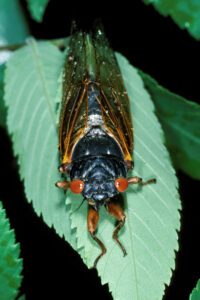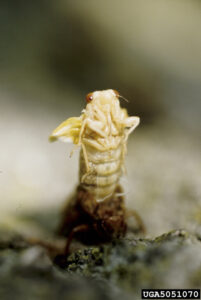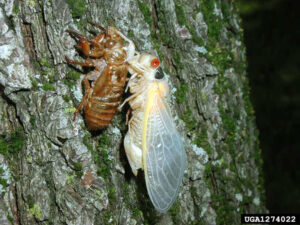
Heather N. Kolich, ANR Agent, UGA Extension Forsyth County
When I leave the house each morning, I hear the calls and songs of several bird species. This spring, we might hear another sound: the raspy song of male periodical cicadas trying to attract a mate throughout the daylight hours. Specifically, we’re expecting Brood XIX (Brood 19) of Magicicada tredecim, one of three broods of 13-year cicadas (each brood emerges in a different year), and the only 13-year cicada known to occur in Georgia.
These periodical cicada nymphs spend 12 years and 11 months underground, sucking sap from deciduous hardwood trees and transitioning through five instars as they mature. The adult insects emerge from the ground in April and May, living only a couple of weeks – long enough to climb up into trees, breed, and lay eggs for the next “Great Southern Brood.”
When Brood XIX emerged in 2011, 75 Georgia counties verified and reported their presence. None were reported from Forsyth County. That doesn’t mean they weren’t here; it just means no one reported sighting them. During previous Brood XIX emergences (1907-1998), Magicicada specimens were documented from only 17 counties.

Although they only occur in the eastern half of the U.S., periodical cicadas are among the most studied insects from the evolution and ecology perspective. There are 13-year and 17-year cicadas, and the mechanisms of their long metamorphosis remain poorly understood.
What is known about periodic cicadas is that they are harmless and provide some ecological benefits during their brief above-ground visit. They are food for fish and wildlife, and cicada predators produce more offspring in emergence years. Periodical cicadas are even edible to humans, provided they’re harvested very shortly after emergence, before their exoskeleton hardens. Periodical cicadas also improve availability of soil nutrients during their underground years, and again as their abundant post-breeding carcasses decompose into the soil. The release of nitrogen from cicada decomposition can continue for months, providing growth enhancement to forest trees for two or more years after the year of cicada emergence.

The predictable mass emergence – both in time and location – of periodic cicadas, along with their docile nature, have made them an ideal subject for participatory science since 1834. This spring, I’m asking Forsyth County residents to watch and listen for 13-year cicadas in our community and take photographs, report, and/or capture specimens of these unique insects for scientific mapping. Reports can be made through the iNaturalist app, and specimens can be submitted to the Forsyth County Extension office.

Brood XIX is easily identifiable from our annual cicadas. The 13-year cicadas emerge in spring and are likely to be gone before the annual cicadas begin to emerge in June. They also look different. Brood XIX cicadas have black bodies and red eyes, and an orange tint to their clear wings. By contrast, annual cicadas have larger, green bodies and black eyes. Annual cicadas will be around throughout the summer and fall.
Some periodical cicada broods have become extinct. Habitat loss can be a factor in population declines and extinctions of many species. Periodic cicada nymphs attach to a hardwood tree root and feed for nearly 13 (or 17) years. If the tree is cut down during that feeding period, the nymphs die. No Brood XIX cicadas have been reported from the Atlanta metro areas, including Forsyth County, possibly because of heavy urbanization. But maybe we just need to listen and look for these astounding insects. If we find them here, that would be amazing; if we look and don’t find them, that’s important information, too.